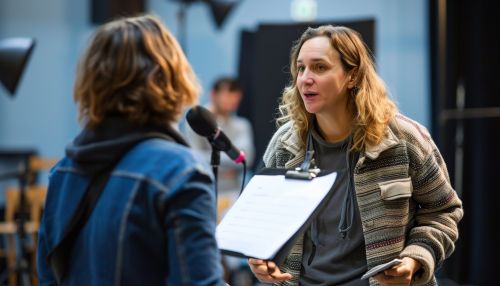Casting (performing arts)
Overview
Casting is a pre-production process in the performing arts industry, where a series of auditions are conducted to select a performer for a particular role or part in a script, screenplay, or teleplay. This process involves a series of auditions where actors perform short pieces, known as sides, and are evaluated on their performance. The casting process is typically managed by a casting director, who works closely with the director and producers to find the right talent for each role.


History
The concept of casting in performing arts has its roots in ancient Greece, where plays were an integral part of the cultural fabric. The Greek playwrights would often write specific roles for specific actors, essentially casting the parts as they wrote the plays. This practice evolved over time, with the advent of professional acting troupes in the Middle Ages, and the establishment of the first professional casting directors in the early 20th century.
Roles and Responsibilities
The casting process involves several key players, each with their own specific roles and responsibilities.
Casting Director
The casting director is responsible for managing the casting process. They work closely with the director and producers to understand the requirements of each role, and then conduct auditions to find the right actors for these roles. The casting director also negotiates contracts and manages the logistics of the casting process.
Director
The director plays a crucial role in the casting process, as they have the final say on who is cast in each role. The director works closely with the casting director to understand the requirements of each role and to evaluate the performances of the actors during the auditions.
Producers
The producers are involved in the casting process to ensure that the cast aligns with the budget and production schedule. They work closely with the casting director and director to select the right actors for each role.
Casting Process
The casting process typically involves several stages, each designed to narrow down the pool of actors to the final cast.
Pre-production
During the pre-production phase, the casting director works with the director and producers to understand the requirements of each role. This involves reading the script, discussing the characters, and developing a casting strategy.
Auditions
The auditions are the main stage of the casting process. Actors are invited to perform short pieces, known as sides, in front of the casting director and other key members of the production team. The performances are evaluated based on a variety of factors, including the actor's ability to embody the character, their chemistry with other actors, and their suitability for the role.
Callbacks
After the initial auditions, a shortlist of actors is invited back for callbacks. This is a more intensive audition process, where the actors may be asked to perform additional sides, or to perform in different combinations with other actors. The callbacks are designed to further evaluate the actors and to make the final casting decisions.
Contract Negotiation
Once the final cast has been selected, the casting director negotiates the contracts with the actors and their agents. This involves agreeing on the terms of the contract, including the actor's fee, the duration of the contract, and any other specific requirements.
Types of Casting
There are several different types of casting in the performing arts industry, each with its own specific processes and requirements.
Open Casting
Open casting, also known as open auditions or cattle calls, is a type of casting where anyone can audition for a role. This is often used for community theatre productions, or when a production is looking for a fresh face or unknown talent.
Closed Casting
Closed casting is a type of casting where only actors who have been invited can audition. This is often used for professional productions, where the casting director has a specific list of actors they want to see for each role.
Type Casting
Type casting is a process where actors are cast in roles that are similar to roles they have played in the past. This can be a double-edged sword for actors, as it can lead to steady work, but can also limit their opportunities to play different types of characters.
Impact on Production
The casting process has a significant impact on the production of a play, film, or television show. The cast is often the most visible aspect of a production, and the right cast can make or break a production. The casting process is also a significant investment of time and resources, and can have a significant impact on the production schedule and budget.
Controversies
The casting process has been subject to several controversies over the years, including issues of typecasting, whitewashing, and ageism. These issues have led to calls for more diversity and inclusivity in the casting process, and for more transparency in the casting process.
